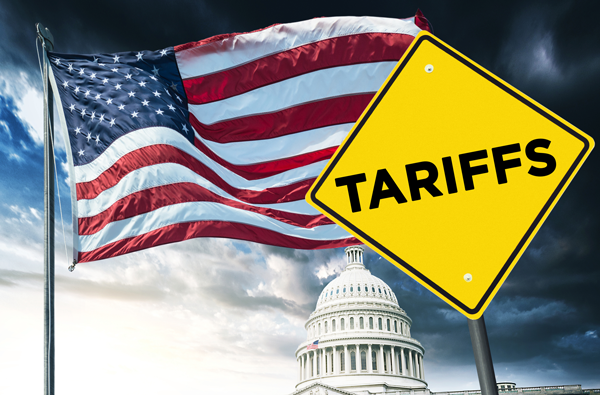
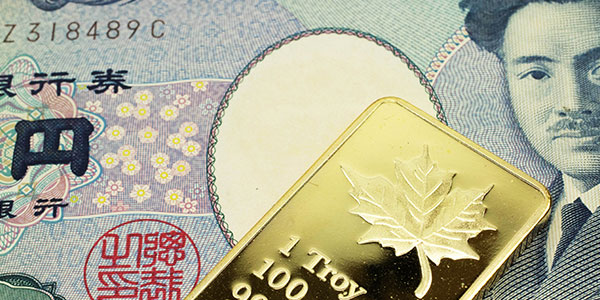
Japan’s New Gold Era: The Yen’s Decline Sparks Unprecedented Demand for Safe Havens
The price of gold just had its best October in nearly half a century, defying tough resistance from surging Treasury yields and a strong U.S. dollar. The yellow metal rallied an incredible 7.3% last month to close at $1,983 an ounce, its strongest October since 1978, when it jumped 11.7%.
Gold, a non-interest-bearing asset, has historically floundered when bond yields were heading higher.
An exception has been made this year, however, on a number of significant economic and geopolitical risks, including record-high national debt, rising credit card delinquencies, ongoing recession jitters (despite Jerome Powell’s insistence that a recession is no longer in the Federal Reserve’s forecasts) and two wars.
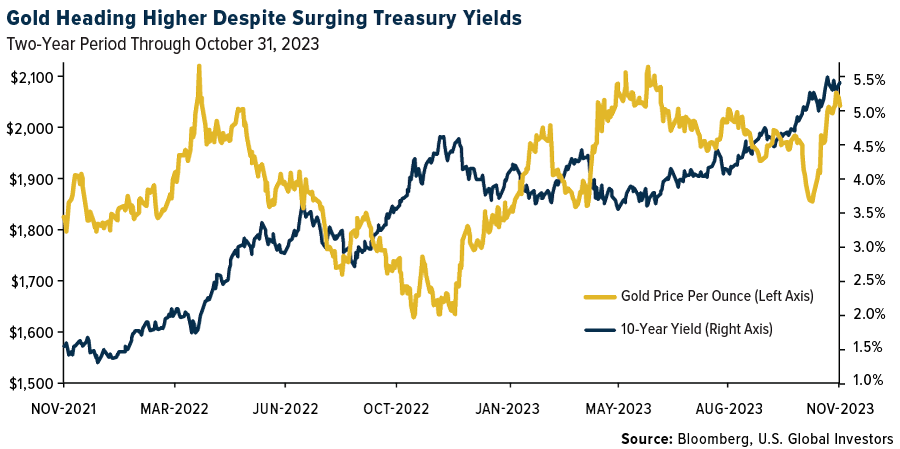
Crafting Your Gold Portfolio in an Uncertain Market
If you believe these conditions will continue to spur investment demand for gold, now may be a good time to consider getting exposure (or adding to your exposure) in anticipation of potentially higher prices.
A word of caution: The metal looks overbought right now based on the 14-day relative strength index (RSI), so we may see some profit-taking in the short term. I believe a strong base is being established, and if stocks recede from this week’s pump, it may be an adequate catalyst for a gold rally. Keep in mind that, for the 30-year period, November has been the best month for stocks, with the S&P 500 increasing an average of 1.96%, based on Bloomberg data.
I recommend a gold weighting of no more than 10%, split evenly between physical bullion (bars, coins and jewelry) and high-quality gold mining stocks, mutual funds and ETFs. Remember to rebalance at least once a year, if not more frequently.
Why Central Banks Are Betting Big on Gold
If you’re still on the fence, take a look at what the official sector has been up to. Central banks bought a collective 337 metric tons of gold in the third quarter, marking the second-largest third quarter on record, according to the latest report by the World Gold Council (WGC). Year-to-date, banks have added a remarkable 800 tons, which is 14% more than they added during the same nine months last year.
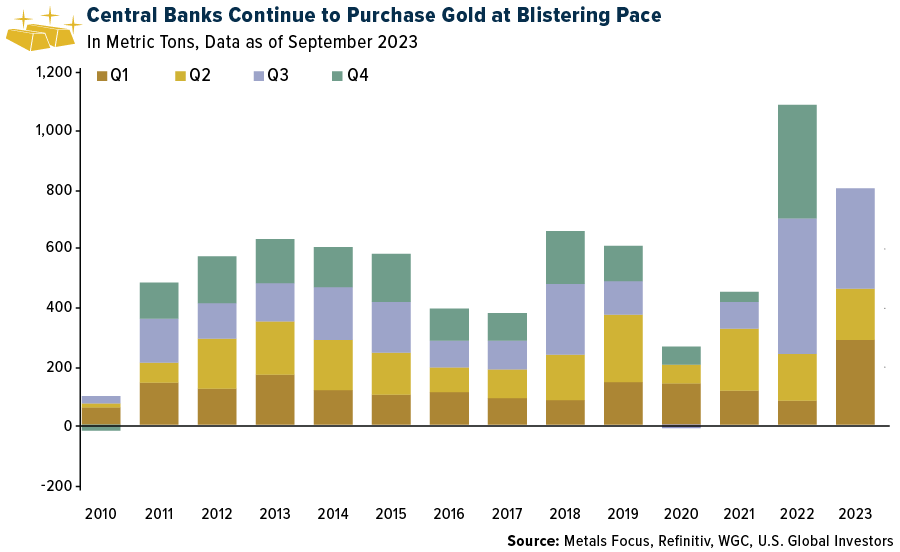
The list of biggest buyers during the third quarter was dominated by emerging markets as countries continue to diversify away from the U.S. dollar. In the top spot was China, which added a massive 78 metric tons of gold, followed by Poland (over 56 tons) and Turkey (39 tons).
I often advise investors to pay attention to what central banks do rather than what they say, but they’re occasionally on point and worth listening to.
During last month’s press conference, for example, National Bank of Poland (NBP) president Adam Glapiński said that the Eastern European country would continue to buy gold, which “makes Poland a more credible country.” The goal is for gold to be 20% of Poland’s total foreign reserves. As of September, gold accounted for 11.2% of its holdings, according to WGC data.
Japan’s Gold Rush
Take a look also at Japan. The country hasn’t traditionally been a big importer of gold, but Japanese investors and households in general have lately bid up the price of the yellow metal to a new all-time high of ¥300,000. That’s a substantial difference from the 30-year average price of just under ¥100,000.
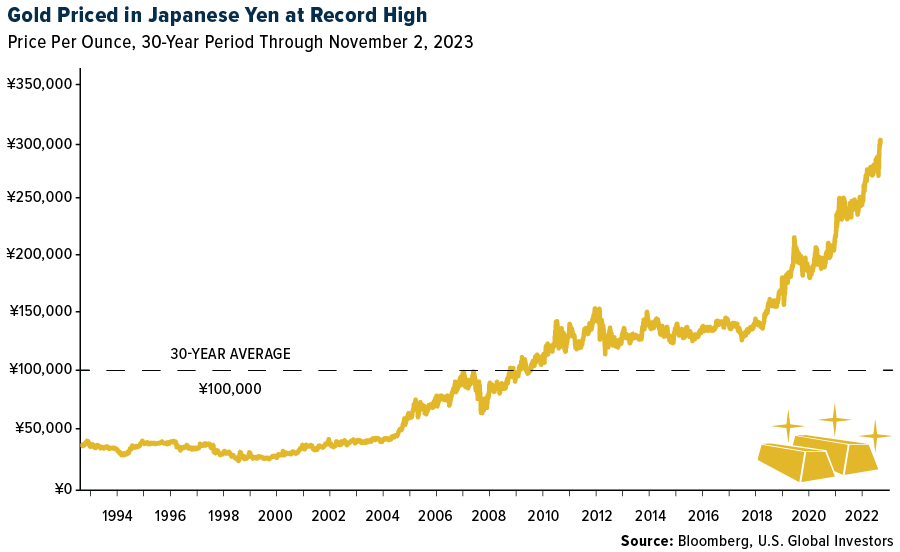
In the medium to near term, Japan’s gold rush has been triggered primarily by the yen’s historic slide against the U.S. dollar, prompting investors to seek a hedge against inflation.
In an attempt to rein in rising consumer prices, Japanese Prime Minister Fumio Kishida has introduced a ¥17 trillion ($113 billion) stimulus package that, among other things, makes temporary cuts to income and residential taxes, assistance to low-income households and gasoline and utility subsidies.
But as many of you are aware, money-printing by world governments, especially during the pandemic, is largely to blame for the current spate of inflation that has cut deeply into consumers’ pocketbooks around the globe. A $113 billion spending plan at this time will act as fuel on a bonfire.
Japanese households appear to understand this, as their approval of Kishida’s job as prime minister has slipped to an all-time low rating of 33%, according to recent polling by Nikkei and Tokyo TV. When asked about the potential tax cuts, a whopping 65% of participants said that they’re an inappropriate response to high inflation.
A better strategy, I believe, is with gold and gold mining equities. As the WGC has shown multiple times, gold has typically fared well during periods of high inflation. Historically, when inflation rates have exceeded 3%—which is where we are today—the average price of gold rose 14%.
For the 12-month period as of today, gold in dollar terms is up 22%, which beats the S&P 500 (up 19% over the same period) and is well above inflation.
All Eyes on Airline Stocks with Oil Prices in Freefall
On a final note, I believe now may also be a good time to consider getting exposure to airline stocks as fuel costs are in freefall. Brent crude, the international benchmark, appears to be breaking down, with the per-barrel price falling below its 50-day moving average. Trading at just under $85 a barrel, Brent was off 8.3% for the 12-month period through November 3.
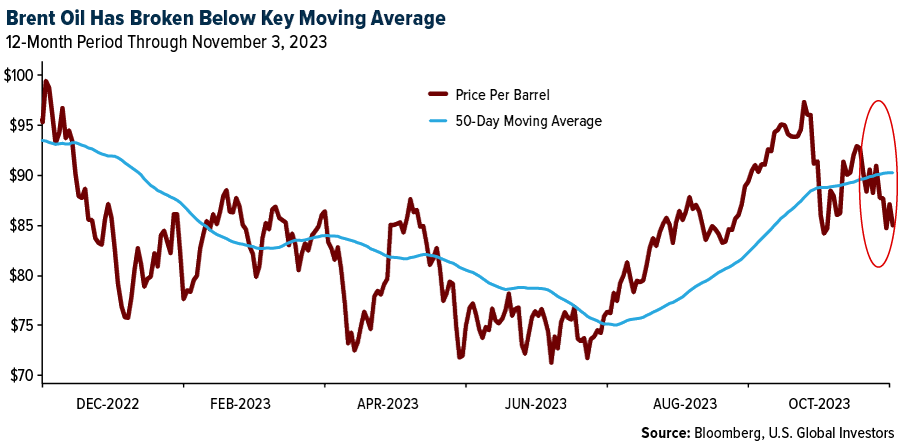
Besides labor, fuel costs are often the largest operating cost for airlines, accounting for between 17% and 22% of operating expenses, according to various estimates. With fuel prices rolling over, I believe gross profit margins may have room to expand.
Watch our latest video on the top five airlines cashing in on non-ticket services by clicking here!

Index Summary
- The major market indices finished up this week. The Dow Jones Industrial Average gained 5.07%. The S&P 500 Stock Index rose 5.86%, while the Nasdaq Composite climbed 6.61%. The Russell 2000 small capitalization index gained 7.52% this week.
- The Hang Seng Composite gained 1.44% this week; while Taiwan was up 2.31% and the KOSPI rose 2.85%.
- The 10-year Treasury bond yield fell 26 basis points to 4.573%.
Airlines and Shipping
Strengths
- The best performing airline stock for the week was Bombardier, up 18.3%. Japan Airlines’ first half earnings before interest and taxes (EBIT) overshot guidance by ¥39 billion, primarily because yields on international routes remained high. The company revised up full-year EBIT guidance from ¥100 billion to ¥130 billion.
- The container spot market improved notably over the past week as liner operators reduced shipping capacity on the route that ships merchandise from Asia to Europe, an analyst said. The Shanghai Container Freight Index rose 10.2% over the past seven days to 1,012, marking the biggest one-week leap since November 2020, Clarksons Securities wrote in a note this week.
- Air Canada’s third quarter EBITDA was 17% above expectations and a solid beat with all regional markets performing better than expected from a revenue perspective. Management is reaffirming guidance for fiscal year 2023, which implies a weaker-than-expected fourth quarter, likely reflecting higher fuel costs and elevated geopolitical risk.
Weaknesses
- The worst performing airline stock for the week was Allegiant, down 4.3%. According to Bank of America, system net sales fell 6.5% year-over-year for the week, compared to a drop of 4.9% for the prior week, and below the trailing four-week average of down 2.9%. Pricing decelerated significantly to -10.4% from -6.8% last week, dragged lower by a five-point deceleration in international pricing while domestic was roughly flat. The recent events in Israel likely caused the international softness, with sales now 12% below 2019 levels for the second consecutive week, a step-change from the post-summer normalization trend seen in recent weeks.
- This year, for the first time, canal authorities in the central American nation cut the number of ships that can cross each day, reducing it to 31 per day, down from the average of about 36. On Tuesday, the canal authority said it would further limit crossings to 25 bookings per day later this week and gradually reduce it before reaching only 18 from February next year.
- JetBlue reported a September quarter adjusted loss per share of ($0.39), worse than FactSet consensus ($0.30). The miss versus consensus was driven by worse-than-expected revenue, non-fuel costs, and tax impact. The company introduced December quarter loss per share guidance of ($0.35) to ($0.55), worse than consensus of ($0.15). Underlying this, revenue is expected to be down 6.5% to 10.5% year-over-year, below the consensus of -1.7%.
Opportunities
- According to Aviation Week, Boeing is close to getting FAA certification on the MAX-7s (before 2023 year-end) and the go-ahead to start formal flight-testing of the MAX-10s. These are steps that could see deliveries start in early 2024 and early 2025, respectively.
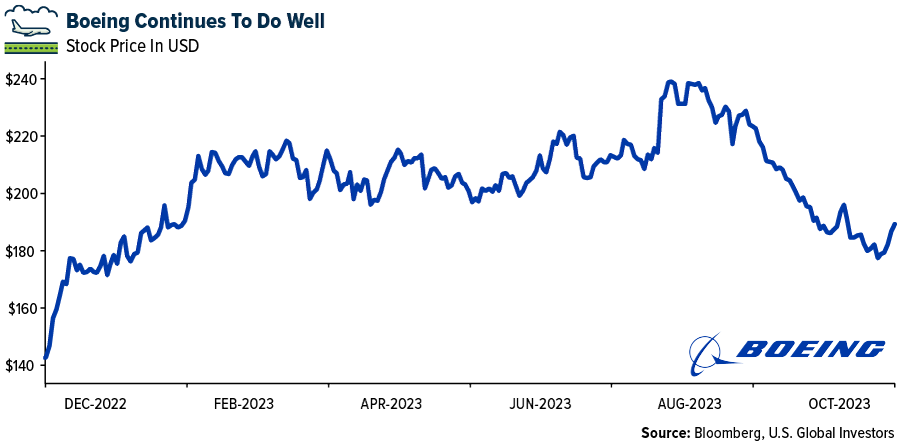
- According to Stifel, although rising crude production from Venezuela is likely to take time given years of underinvestment and field cannibalization. As it does recover, it should be primarily beneficial to Aframax and Suezmax demand, although more crude could, in time, make it to the VLCC market as well.
- The National Civil Aviation Agency (Anac) launched a hot site this week consolidating information about the regulations for attracting foreign airlines to Brazil. According to Anac, the aim is to promote increased competition in the sector, enhance the country’s connection with foreign destinations and further democratize access to air transportation. In September last year, the sector went through a reformulation of rules which resulted in a swifter registration process for foreign airlines, reducing the average processing time from 270 days to 30 days.
Threats
- JPMorgan does not think JetBlue management, and more likely its Board, want to buy the Spirit franchise for $35 per share. The bank believes stand-alone Spirit, given recent and forecasted results, would potentially trade close to $5 if the merger arb influence was removed.
- “Overcapacity will persist next year and, along with stricter environmental regulations, will prompt more scrapping of elderly tonnage and slow steaming, said COSCO corporate secretary Xiao Junguang. “Looking into 2024, the global economy is expected to stabilize and recover. According to WTO estimates, global trade is estimated to grow 3.3%.” In addition, according to Sea-Intelligence’s latest report, the current tonnage overhang will peak next year, and be fully resolved by 2028.
- According to JPMorgan, Spirit liquidity is down to $1.2 billion and likely will fall further. Given a revenue base of $5.4 billion, the bank thinks a liquidity/revenue ratio of 15% (or just over $800mm) is the best guess at the realistic structural minimum. JPMorgan thinks a credit card holdback kicks in for Spirit at 10%.
Luxury Goods and International Markets
Strengths
- Ferrari reported strong quarterly results this week and raised its full-year outlook. The top-of-the-line car maker has been able to raise prices for some models with its wealthy customers less impacted by soaring inflation and rising interest rates. Shipments of limited-edition models such as the EUR 2 million ($2.1 million) Daytona SP3 helped to boost third-quarter profits.
- Apollo Global Management, a private equity firm, reported a third-quarter profit of $660 million, after a year-ago loss of $563 million. CEO Mark Rowan said that sticker regulations and higher capital requirements have restricted lending by big banks and pushed that business to investors and private markets. Higher interest rates and investor demand for private credit benefited the company.
- Toll Brothers, a homebuilder, was the best performing S&P Global Luxury stock, gaining 18.2% in the past five days. Seaport Research upgraded the company to a buy from neutral, with a price target of $93. On Friday, shares closed at $81.3.
Weaknesses
- The final S&P Global U.S. Manufacturing PMI was unchanged in October, remaining at the 50 level. However, the U.S. Services PMI was reported at 50.6 in October, below the expected 50.9. Final U.S. Composite PMI was revised down to 50.7 from 51.0.
- Moncler, an Italian specialty apparel retailer, reported revenue growth of 7% (down from 26%) during the second quarter and 23% during the first quarter. The slowdown was mainly due to challenging year-over-year comparison, and weaker reported sales, especially in America and Europe. Asia grew at a robust pace of 22% but slowed from 55% and 32% in the second and first quarters, respectively.
- Estee Lauder, a beauty product maker and distributor, was the worst performing S&P Global Luxury stock, losing 10.6% in the past five days. Shares declined after the company announced quarterly earnings, cutting its full-year sales forecast. For the current fiscal year, the company now expects net sales to be in the range of a decrease of 2% to an increase of 1%. Back in August, the company was forecasting net sales to increase between 5-7%.
Opportunities
- Hong Kong has regained its spot as the market with the highest per capita spending on luxury goods, (after losing it to Switzerland and the UAE), with jewelry and watches having the biggest positive impact. According to the World Market for Luxury Goods report by Euromonitor, Hong Kong is set to regain pre-pandemic levels of luxury sales by mid-2024, and Hong Kong is expected to maintain its current lead as the city with the highest per capita spending on luxury goods up until 2028.
- On Friday, in Germany, BMW AG reported a margin of 9.8% in the third quarter for its luxury car business, exceeding analyst expectations. Sales of premium cars as well as electric vehicle deliveries increased. CEO Oliver Zipse is optimistic about its luxury and EV sales in 2024, offering a rare positive outlook among German carmakers as weaker demand in China puts pressure on the auto sector.
- On Wednesday, the Federal Reserve kept rates unchanged in a target range between 5.25%-5.5%. This was the second consecutive meeting that the Federal Open Markets Committee decided to leave the rates unchanged following a string of 11 rate hikes, including four this year. Global markets rallied and the dollar weakened on expectations that the Federal Reserve has completed its tightening cycle.
Threats
- The Eurozone reported weaker-than-expected gross domestic product (GDP). The region’s quarterly GDP contracted by 0.1%, and the year-over-year growth in the Euro-area barely avoided contraction, slowing to a positive 0.1% growth from 0.3% in the second quarter. Piper Sandler’s research team predicts the year-over-year Eurozone GDP to slide to a negative 1.5% next year.
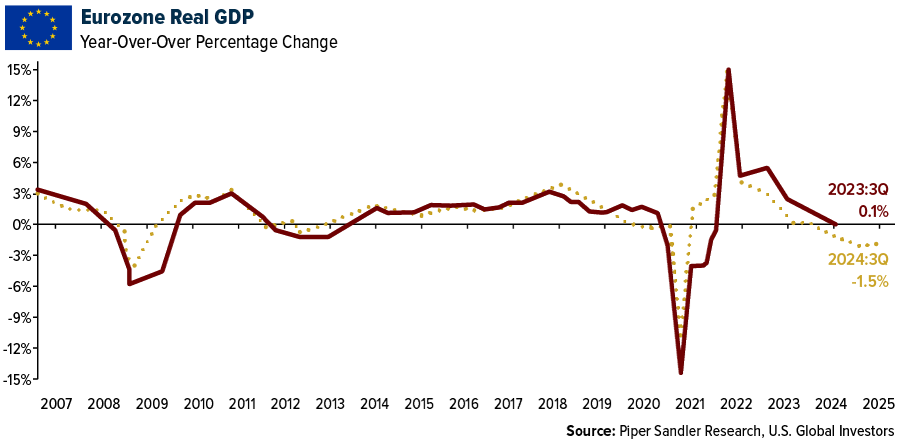
- Apple warned of sluggish fourth-quarter sales during the upcoming holiday season, predicting sales to be about the same as last year. Wall Street had projected revenue growth of about 5% in the last quarter of this year, but it may not materialize due to a slowdown in China. Apple’s September-quarter revenue in China dropped 2.5% to $15.1 billion. That represented the lowest sales in the region since the middle of 2022.
- China’s Manufacturing PMI dipped below 50 and back into contractionary territory. Bloomberg economists were expecting Chinese manufacturing activity to remain in expansionary territory, but the October Manufacturing PMI was released at 49.5 versus 50.2 expected. China’s Non-Manufacturing PMI stayed above 50, but the index was reported at 50.6 for October versus the expected 52.0.

Energy and Natural Resources
Strengths
- The best performing commodity for the week was coffee, rising 6.18%, as inventories hit a 24-year low, reports Bloomberg. Iron ore rallied to the highest level in more than five weeks, extending its rebound on hopes of stronger Chinese demand. Futures in Singapore advanced, building on a gain of over 6% last week.
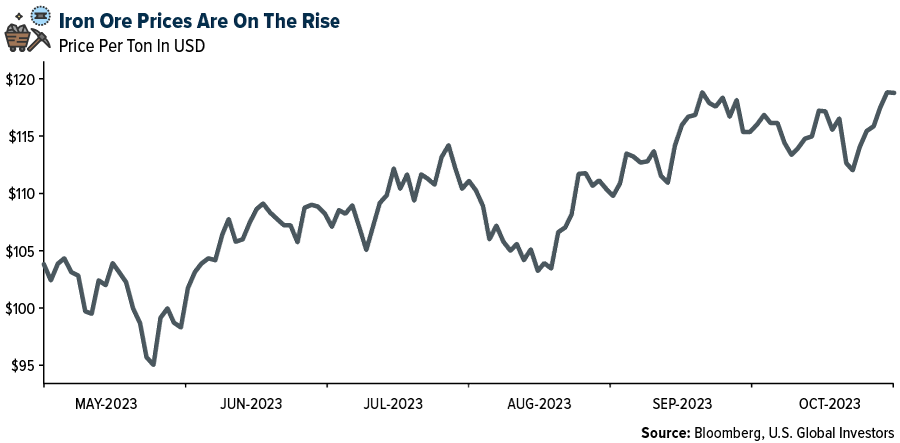
- ConocoPhillips jumped almost 6% after the oil explorer boosted investor payouts and raised its production outlook. The company announced a 14% increase in dividends to 58 cents a share while posting better-than-expected third quarter
profit, according to a statement Thursday. Full-year oil output will reach the equivalent of 1.82 million barrels a day, up from the previous forecast of 1.8 million to 1.81 million, after ConocoPhillips expanded its holdings in Canada’s oil-sands region. - Zinc futures rose as much as 7% after Trafigura Group’s Nyrstar announced it would shut down two mines in Tennessee due to a slump in prices. Nyrstar said in a statement that the mines would be “temporarily pausing production,” on November 30 and would lay off some employees. The company cited falling zinc prices and higher production costs.
Weaknesses
- The worst performing commodity for the week was cotton, dropping 5.64%, to near three-month lows, as the U.S. harvest nears the halfway mark and global supplies look to be trending to a surplus as demand has lightened up too. Saudi Arabia may refrain from increasing its flagship oil price for Asian customers for the first time in six months as refinery margins weaken across the region,
undercutting demand for physical cargoes. - Glencore Plc said it will produce almost 10% less nickel this year than previously forecast, potentially supporting slumping prices of the key battery making ingredient. Nickel, used in both batteries and stainless steel, is trading near a two-year low after suffering a steady decline as a wave of new production from Indonesia overwhelms sputtering demand.
- Oil erased its gains since the war in the Middle East began as Israel faces growing pressure to limit its bombardments to help hostage negotiations, keeping the conflict limited entering its fourth week. West Texas Intermediate fell as much as 4.3%, with losses accelerating after crude slipped below technical support levels near $82 a barrel. Israel’s ground incursion into Gaza has so far been less extensive than some investors expected, and the risk premium that received a boost on Friday as the invasion commenced has since been wiped out.
Opportunities
- According to BMO, M&A activity often picks up when near-term prices become disconnected from perceived long-term values. The last major wave of oil sands consolidation occurred in 2016 and 2017, which followed the collapse in oil prices in 2015. While oil prices have not collapsed, the group believes that current equity values do not fully reflect the long-term value or free cash flow generating ability of the group. BMO also sees significant scope for meaningful cost savings and operating synergies which could make mergers attractive for corporates and investors.
- According to Bank of America, scientists from the University of Lorraine, France have discovered high levels of hydrogen dissolved in water in geologic formations 1200 meters below the surface in southeastern France. These researchers estimate the deposit could contain 46 million tons of “white” hydrogen, which is roughly half the annual global production of gray hydrogen. While significant additional borings into this basin will be needed to confirm these estimates, this finding could significantly underpin Europe’s pursuit of hydrogen as a non-carbon energy source.
- Electricity supplier Southern Co. which has plants in Alabama, Georgia, and Mississippi, expects electricity sales to grow in the high single digits over the next five years due to rising electricity demand for the manufacturing plants of solar panels, batteries, airplanes, and electric cars that are growing in the southern U.S. Daniel Tucker, CFO of Southern, cited what he calls an “extraordinary level” of economic development in the region.
Threats
- Restrictions on vessel passage through the Panama Canal have snarled trade. A lack of rain has dropped the storage water in the reservoirs used to cycle in the canal to lift the ships through. Trips through the canal are down to 18 per day, a 50% drop from a year earlier, as reported on Bloomberg. Diverted ships either alter their path to the Suez Canal or around the bottom of South America – adding at least a week to their transport time which is inflationary for transportation costs.
- Protests were rampant early in the week causing the government to cave to protest demands for shutting down the Cobre Mine. However, Panama’s congress backtracked on revoking the controversial contract awarded to Canadian copper miner First Quantum Minerals Ltd. Lawmakers instead shifted the decision to the Supreme Court and then passed a bill that would put a moratorium on new permits for metal mining. Panama’s creditability to mange its internal woes and deal with slumping traffic through the canal saw their bonds sink the most of Latin America’s sovereign debt over the past month. Moody’s cut its credit rating to a level above junk.
- China has announced it will expand export controls to include a range of graphite products, effective from December 1. Graphite is the largest component in lithium-ion EV batteries by weight, used for the anode. BNEF Metals Research and Analysis reports that flack and spherical graphite are the targeted products, but the bulk of China’s exports are synthetic graphite which is not being restricted.
Bitcoin and Digital Assets
Strengths
- Of the cryptocurrencies tracked by CoinMarketCap, the best performer for the week was ThorChain, rising 33.69%.
- Bitcoin briefly set a fresh, 17-month high before retreating from the $35,000 price level as traders say the battle between crypto bulls and bears is intensifying in the derivates market, writes Bloomberg. In addition, the digital currency has witnessed recent strong performance in part due to optimism over the imminent approval of a handful of spot ETF products.
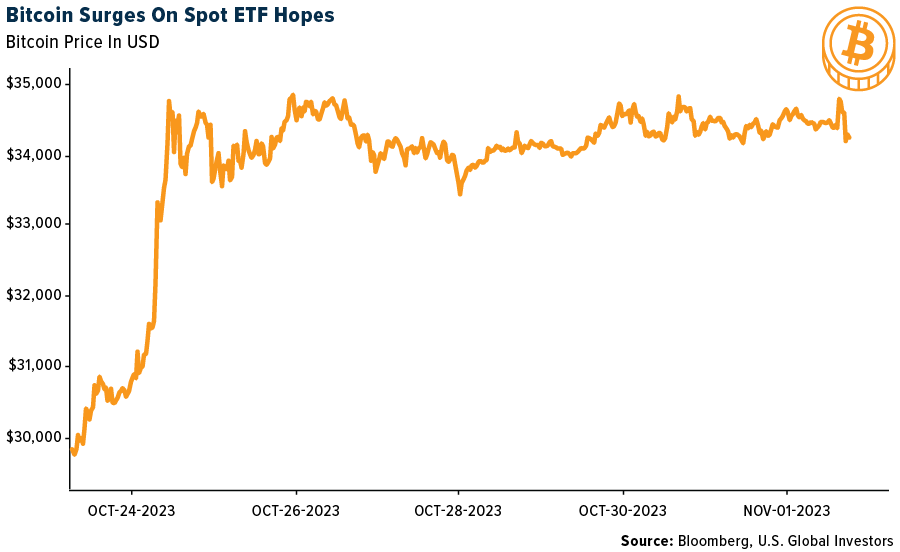
- Hong Kong is set to allow primary dealing of tokenization by providing more guidance on tokenized securities-related activities, the Securities and Futures Commission (SFC) announced on Thursday. The move appears to be another step in Hong Kong’s recently accelerated ambitions to become a virtual asset hub, writes Bloomberg.
Weaknesses
- Of the cryptocurrencies tracked by CoinMarketCap, the worst performer for the week was Quant, down 10.54%.
- PayPal holdings received a subpoena from the U.S. securities and exchange commission’s (SEC’s) division of enforcement related to its work on a dollar-linked stablecoin, according to Bloomberg.
- Sam Bankman-Fried was convicted of massive fraud that led to the collapse of his FTX exchange, following a month-long trial that pitted the testimony of the former crypto king against that of some of his closest friends. Bankman-Fried was found guilty of seven counts of fraud and faces as much as 20 years in prison, according to Bloomberg.
Opportunities
- HSBC Holdings launched a platform that uses distributed ledger technology to tokenize ownership of physical gold held in its London Vault. The new system created digital tokens that represent gold bars, writes Bloomberg.
- Bitcoin miner Marathon Digital has started a pilot mining project in Utah that uses methane gas generated from landfill waste to make electricity to power mining operations, according to Bloomberg.
- The Swiss National Bank will launch the pilot phase of its planned digital wholesale franc in December. The project, in collaboration with six commercial banks from Switzerland and Germany and the Swiss stock exchange, will entail issuing a digital Swiss franc on a blockchain using distributed ledger technology, writes Bloomberg.
Threats
- Taiwan police have busted what appears to be the country’s largest crypto related money laundering case. The police agency’s criminal investigation bureau said in a statement that the police force in June arrested suspect Chieu, who allegedly processed over 324 million USDT to launder money involved in an investment fraud case, writes Bloomberg.
- Analysts expect to see negative short-term price action if a bitcoin spot ETF is rejected by the SEC, writes CoinDesk. Analysts, however, pointed out that bitcoin certainly doesn’t hinge its existence on an ETF.
- Telegram trading bot, Unibot, said it would reimburse any stolen funds after being the victim of a token approval exploit that drained the protocol for over $600,000. This is the latest exploit in the crypto world, writes Bloomberg.

Gold Market
This week gold futures closed at $1,999.00, up $0.50 per ounce, or 0.03%. Gold stocks, as measured by the NYSE Arca Gold Miners Index, ended the week higher by 0.59%. The S&P/TSX Venture Index came in up 0.91%. The U.S. Trade-Weighted Dollar fell 1.34%.
Strengths
- The best performing precious metal for the week was platinum, up 4.90%, but lacked headline news around the price movement. Gold futures put in their fourth weekly gain, although without the lower payrolls number reported on Friday, it was heading for a loss. Interest rates fell on the news with a pause more likely for the next Federal Reserve meeting. The Bank of Thailand views gold as a relative haven in an era of high inflation and growing geopolitical risks, according to a central bank official, as the Southeast Asian nation seeks to safeguard its $210 billion of foreign reserves from market turbulence. The Thai central bank has increased its gold holdings over the past three years as it diversified its investments, Deputy Governor Alisara Mahasandana said in an interview.
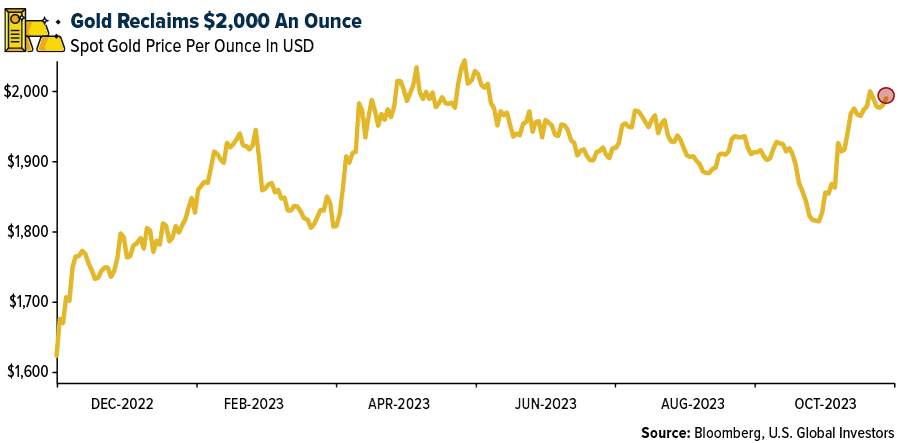
- Marathon Gold announced that the Berry deposit has been released from the provincial Environmental Assessment (EA) process. This allows the project to proceed to provincial permitting while review at the federal level remains ongoing. On the latter, the company has received confirmation from the Impact Assessment Agency of Canada (IAAC) that the Berry expansion does not constitute a new project federally, so should not require a new impact assessment.
- Fortuna Silver reported that the Mexican Federal Administrative Court has ruled in its favor by re-instating the 12-year EIA for the San Jose Mine, following legal proceedings initiated by SEMARNAT in January 2023. The Court decision is subject to appeal by SEMARNAT, and if appealed, Fortuna noted that the permanent injunction already in place will remain in effect. The San Jose mine accounts for 5% of net asset valuation and is expected to contribute 27% of operating cash flow in 2023.
Weaknesses
- The worst performing precious metal for the week was palladium, down 0.19%. SSR Mining dropped as much as 14%, the most intraday since June 2022, after the precious metal miner’s gold production missed estimates and realized silver prices also disappointed. National Bank said the earnings results were “clouded” given foreign exchange and tax changes in Turkey, while cash flows missed.
- For St. Barbara, gold production of 17,000 ounces was 34% below consensus. AISC of A$3951 per ounce were well above consensus A$2652 per ounce. As expected, Atlantic shut during the quarter, with Simberi driving the miss. There were two Simberi plant shutdowns in the first quarter and lower gold recovery from a high Sulphur to gold ore feed. SBM expects these issues to improve over fiscal year 2024.
- Buenaventura earnings per share (EPS) was $0.06 versus consensus of $0.19. The lower EPS was due to lower sales and higher costs. The company pre-released its production and sales results earlier this month. Costs of sales and AISC from direct operations of $1,501/GEO and $2,166/GEO were 17% higher and 23% higher than consensus of $1,281/GEO and $1,768/GEO, respectively.
Opportunities
- Tietto Minerals Ltd. surged as much as 37%, the most since March 2020, after the Sydney-listed gold producer received a conditional, non-binding indicative proposal from a unit of Zhaojin Mining Industry Co. that values the firm at about A$654 million ($415 million).
- While solar panel use has expanded dramatically, solar cell manufacturers have cut by 50% the amount of silver required for a panel over the last six years. That trend looks to be coming to a stop with the next generation of solar panels requiring 50% to up to 175% more silver to boost the efficiency of the panels to collect energy. The Silver Institute reports that the photo voltaic industry consumed over 10% of global silver supply in 2022. Additional silver demand, when supply can’t be just turned on, would have a meaningful impact on prices.
- Reporting gold purchases for the third quarter, the World Gold Council notes that “Net central bank buying of 337 tons was the third strongest quarter in our data series, although failed to match the exceptional 459 tons from Q3’22. Yet, demand from central banks year-to-date is 14% ahead of the same period last year at a record 800 tons.” However, total investor purchases remained below their previous high, so they have been enough to support gold, but insufficient to drive prices higher.
Threats
- West African Resource says that following consultation with the country’s gold mining industry, Burkina Faso’s government has increased royalty rates for gold producers. The new royalty rates take effect in November and are expected to increase the company’s 2023 AISC by approximately $6 to $8 per ounce at current gold prices.
- For Endeavor Mining, Burkina Faso has revised its royalty rates (effective November 2023) which now incorporate a sliding scale royalty that increases to a maximum 7% at gold price $2,000 per ounce. This is in comparison to the previous maximum royalty rate of 5%.
- According to RBC, for Franco Nevada and its Panama difficulties the group notes: 1) the stock down another 10% from here to $110 per share level would likely price out Cobre Panama completely, assuming a flat gold price, 2) Franco’s dividend is not affected on its model if Cobre gets fully shut, as only 20% of the company’s free cash flow is allocated to the dividend and the company has $1.3 billion in net cash, and 3) without Cobre, Franco’s outlook is less competitive versus peers Royal Gold and Wheaton Precious Metals.


U.S. Global Investors, Inc. is an investment adviser registered with the Securities and Exchange Commission (“SEC”). This does not mean that we are sponsored, recommended, or approved by the SEC, or that our abilities or qualifications in any respect have been passed upon by the SEC or any officer of the SEC.
This commentary should not be considered a solicitation or offering of any investment product. Certain materials in this commentary may contain dated information. The information provided was current at the time of publication. Some links above may be directed to third-party websites. U.S. Global Investors does not endorse all information supplied by these websites and is not responsible for their content. All opinions expressed and data provided are subject to change without notice. Some of these opinions may not be appropriate to every investor.
Holdings may change daily. Holdings are reported as of the most recent quarter-end. The following securities mentioned in the article were held by one or more accounts managed by U.S. Global Investors as of (09/30/2023):
Japan Airlines
Air Canada
JetBlue Airways
Boeing
COSCO Shipping Holdings
ConocoPhillips
Ferrari
Apollo Global Management
BMW AG
Moncler
West African Resource
Franco Nevada
Royal Gold
Wheaton Precious Metals
*The above-mentioned indices are not total returns. These returns reflect simple appreciation only and do not reflect dividend reinvestment.
The Dow Jones Industrial Average is a price-weighted average of 30 blue chip stocks that are generally leaders in their industry. The S&P 500 Stock Index is a widely recognized capitalization-weighted index of 500 common stock prices in U.S. companies. The Nasdaq Composite Index is a capitalization-weighted index of all Nasdaq National Market and SmallCap stocks. The Russell 2000 Index® is a U.S. equity index measuring the performance of the 2,000 smallest companies in the Russell 3000®, a widely recognized small-cap index.
The Hang Seng Composite Index is a market capitalization-weighted index that comprises the top 200 companies listed on Stock Exchange of Hong Kong, based on average market cap for the 12 months. The Taiwan Stock Exchange Index is a capitalization-weighted index of all listed common shares traded on the Taiwan Stock Exchange. The Korea Stock Price Index is a capitalization-weighted index of all common shares and preferred shares on the Korean Stock Exchanges.
The Philadelphia Stock Exchange Gold and Silver Index (XAU) is a capitalization-weighted index that includes the leading companies involved in the mining of gold and silver. The U.S. Trade Weighted Dollar Index provides a general indication of the international value of the U.S. dollar. The S&P/TSX Canadian Gold Capped Sector Index is a modified capitalization-weighted index, whose equity weights are capped 25 percent and index constituents are derived from a subset stock pool of S&P/TSX Composite Index stocks. The NYSE Arca Gold Miners Index is a modified market capitalization weighted index comprised of publicly traded companies involved primarily in the mining for gold and silver. The S&P/TSX Venture Composite Index is a broad market indicator for the Canadian venture capital market. The index is market capitalization weighted and, at its inception, included 531 companies. A quarterly revision process is used to remove companies that comprise less than 0.05% of the weight of the index, and add companies whose weight, when included, will be greater than 0.05% of the index.
The S&P 500 Energy Index is a capitalization-weighted index that tracks the companies in the energy sector as a subset of the S&P 500. The S&P 500 Materials Index is a capitalization-weighted index that tracks the companies in the material sector as a subset of the S&P 500. The S&P 500 Financials Index is a capitalization-weighted index. The index was developed with a base level of 10 for the 1941-43 base period. The S&P 500 Industrials Index is a Materials Index is a capitalization-weighted index that tracks the companies in the industrial sector as a subset of the S&P 500. The S&P 500 Consumer Discretionary Index is a capitalization-weighted index that tracks the companies in the consumer discretionary sector as a subset of the S&P 500. The S&P 500 Information Technology Index is a capitalization-weighted index that tracks the companies in the information technology sector as a subset of the S&P 500. The S&P 500 Consumer Staples Index is a Materials Index is a capitalization-weighted index that tracks the companies in the consumer staples sector as a subset of the S&P 500. The S&P 500 Utilities Index is a capitalization-weighted index that tracks the companies in the utilities sector as a subset of the S&P 500. The S&P 500 Healthcare Index is a capitalization-weighted index that tracks the companies in the healthcare sector as a subset of the S&P 500. The S&P 500 Telecom Index is a Materials Index is a capitalization-weighted index that tracks the companies in the telecom sector as a subset of the S&P 500.
The Consumer Price Index (CPI) is one of the most widely recognized price measures for tracking the price of a market basket of goods and services purchased by individuals. The weights of components are based on consumer spending patterns. The Purchasing Manager’s Index is an indicator of the economic health of the manufacturing sector. The PMI index is based on five major indicators: new orders, inventory levels, production, supplier deliveries and the employment environment. Gross domestic product (GDP) is the monetary value of all the finished goods and services produced within a country’s borders in a specific time period, though GDP is usually calculated on an annual basis. It includes all private and public consumption, government outlays, investments and exports less imports that occur within a defined territory.
The S&P Global Luxury Index is comprised of 80 of the largest publicly traded companies engaged in the production or distribution of luxury goods or the provision of luxury services that meet specific investibility requirements.
The Shanghai Containerized Freight Index reflects the fluctuation of spot freight rates on export container transport market from Shanghai.





























